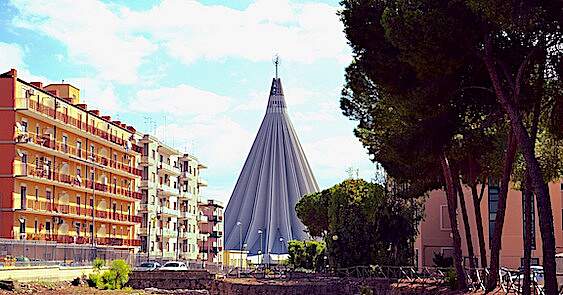
In Syracuse, the Shrine of Our Lady of Tears (Madonna delle lacrime) is the newest and most visited shrine in Sicily, with visitors coming from all over the world.
It all began with a painted plaster plaque representing the Immaculate Heart of Mary crowned with thorns and surmounted with flames (just like in Fatima), in a modest house, placed on the wall over the bed of newly-wed Angelo and Antonina Iannuso. From August 29, 1953 to September 1, 1953, the image wept tears, which were scientifically analyzed.
The Episcopate of Sicily carried out an investigation which proved conclusive. It recognized the supernatural origin of the phenomenon and promoted the veneration of the image. A large shrine was then built.
If we look at the history of the Church leading up to this miracle in Syracuse, we can see a connection with the message of the Virgin Mary in Fatima, Portugal: between October 30 and November 8, 1950, in the days surrounding the solemn definition of the dogma of the Assumption (November 1, 1950), Pope Pius XII personally witnessed the same miracle of the sun of Fatima that had first occurred on October 13, 1917, but this time from the Vatican gardens. Then, in May 1952, Our Lady appeared again to Sister Lucia to tell her that she was still waiting for the consecration of Russia.
Consequently, on July 7, 1952, Pius XII, in his apostolic letter Sacro Vergente Anno, wrote that he was "consecrating in a very special way all the peoples of Russia to the Immaculate Heart of Mary." Russia was named in the text, but this was not accompanied by a public and solemn ceremony, and the bishops of the world were not called to participate in it. During the following summer, Sister Lucia wrote about this consecration: "I am saddened that it was not done in the manner that Our Lady had requested."
The miracle of the tears of Our Lady in Syracuse happened the very next year. It was followed by many miracles, reported all over the world by the media.
Pius XII apparently did not see the connection with Fatima, but Pope John Paul II made the connection explicitly in his homily at the dedication of the Shrine:
"Mary's tears are flowing in the apparitions that accompany the Church on her journey through the world. Mary wept at La Salette, in the middle of the last century, before the apparitions at Lourdes, at a time when Christianity was experiencing growing hostility in France. She wept here again, in Syracuse, at the end of the Second World War. It is possible to interpret these tears against the background of these tragic events: the immense slaughter caused by the conflict; the extermination of the sons and daughters of Israel; and the threat to Eastern Europe posed by openly atheistic communism. Mary's tears are signs: they testify to the presence of the Mother in the Church and in the world. A mother cries when she sees her sons threatened by an evil, whether spiritual or physical."
Pope Saint John Paul II - Excerpt from his homily for the dedication of the Shrine of Our Lady of Tears, Syracuse, Sicily, on November 6, 1994